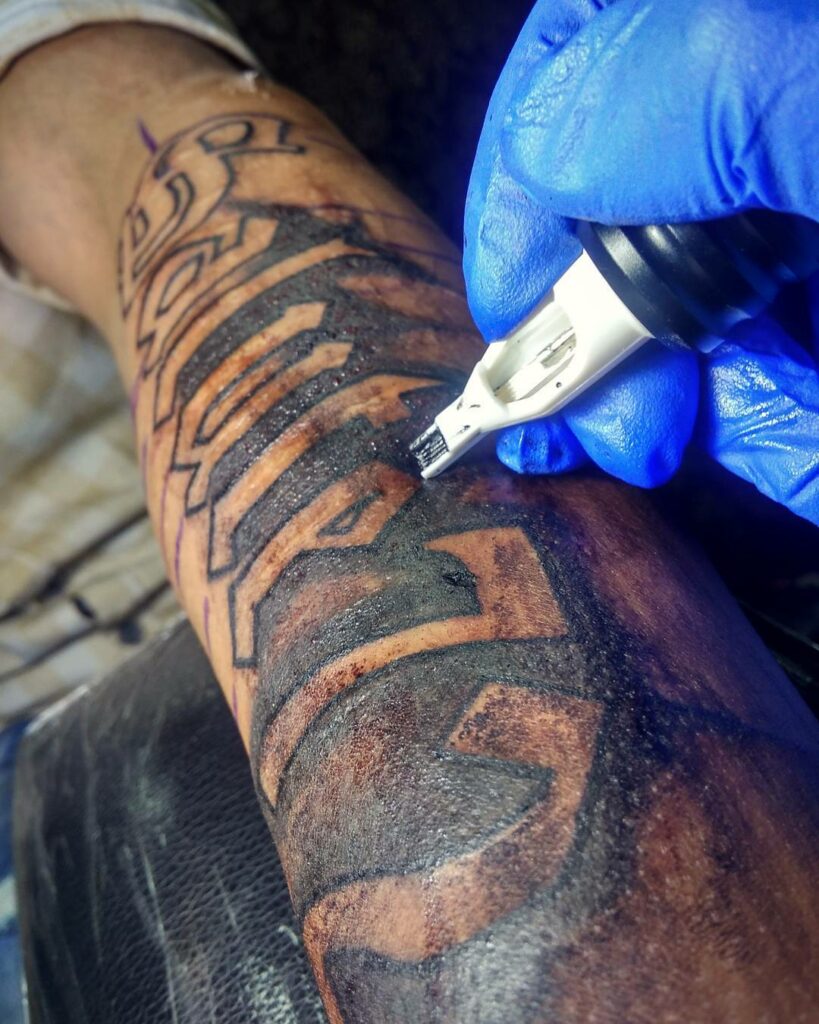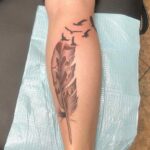Table of Contents
We’re not talking about a horror movie plot, but a natural process in the artistry of body modification. In this post, I’ll dissect the topic of tattoo bleeding, when it’s normal and, more importantly, when it should raise a red flag. I’ll guide you through the labyrinth of your skin’s response to the inky invader, and arm you with the knowledge to discern between a common side-effect and a potential concern.

With decades of etching experiences and anecdotes from my treasure chest of tattoo tales, I promise you a voyage of learning and laughs. As they say, knowledge is power, and it’s about time we powered up! So grab your preferred beverage, get comfortable, and let’s put an end to the guessing game of ‘To Bleed or Not to Bleed’. Your journey into mastering the art of tattoos, one post at a time, starts right here.
Do All New Tattoos Bleed And How Long Do They Bleed For?
Let’s cut to the chase, tattoos and a bit of blood go together like the needle and ink. But how much you bleed and for how long can depend on a few things. Generally, your fresh tattoo might leak a cocktail of blood, plasma, and ink for about 12 to 36 hours. After this, your superhero skin kicks in, starts healing, and halts the leakage with a scab formation.
If you’ve had a few drinks or popped a painkiller before your tattoo appointment, your tattoo might bleed a little more. Why? These bad boys thin your blood. Result? More bleeding and a delay in the scab formation. Been there, done that, and trust me, it wasn’t a fun ride.

It’s important to remember we’re all unique masterpieces. We bleed differently because of our genetics, blood composition, and even the body part being tattooed. Funny story – when I got my shoulders tattooed, they bled more than the rest of my arms. Bizarre, right? But that’s just me. Your shoulders might not even flinch.
Key Factors besides medication that can cause prolonged bleeding after getting a tattoo are:
- Physical Activity: Engaging in strenuous physical activities soon after getting inked can lead to prolonged bleeding. Exercise increases blood flow, which can delay clotting and scabbing, hence extending the bleeding period.
- Diet: Certain foods, including those rich in omega-3 fatty acids, garlic, ginger, and vitamin E, may have blood-thinning effects, potentially prolonging bleeding.
- Hydration: While staying well-hydrated is generally a good thing, excessive hydration can thin your blood, making it harder for your body to stop the bleeding after a tattoo.
- Tattoo Location: Different areas of the body bleed differently due to variations in blood pressure and vascularization. Areas with a dense network of blood vessels, such as the neck or inner arm, may bleed more than less vascular areas like the upper arm or thigh.
- Tattoo Size and Depth: Larger, deeper tattoos may cause more trauma to the skin and blood vessels, leading to more bleeding.
- Individual Physiology: Every person’s body reacts differently to the tattooing process. Some people naturally have blood that clots slower than others. Others may have a higher number of blood vessels in the skin, leading to more bleeding.
- Health Conditions: Certain health conditions can lead to prolonged bleeding, such as clotting disorders, liver disease, and some genetic conditions.
It’s essential to discuss any potential concerns with your tattoo artist before your session and consult with a healthcare provider if you have any health conditions or are taking medications that might affect your bleeding or healing process.
What To Do If A New Tattoo Doesn’t Stop Bleeding

So, we know everyone bleeds during and after a tattoo, but what if your tattoo keeps bleeding longer than expected?
First thing, don’t freak out! Some folks naturally leak a bit longer than others. But if it’s been over 48 hours and you’re still bleeding, there might be a few culprits. That extra beer, painkiller, or blood-thinning medicine could be messing with your healing process. And remember, if you’re on blood-thinning meds for health reasons, always consult your doctor before changing your medication routine.

Another possible troublemaker is your post-tattoo workout. Those hardcore gym sessions might interrupt your body’s healing process, making your tattoo bleed longer. Lastly, if the bleeding doesn’t stop, it might indicate an infection. This is rare nowadays thanks to our ultra-clean tattoo environments and meticulous aftercare instructions, but better safe than sorry. If you suspect infection, does it fit into any of these area
Identifying an infection early after getting a tattoo can help prevent complications and promote a smoother healing process. Here are some signs of an infection to look out for:
- Prolonged Redness or Swelling: It’s normal for the skin around a new tattoo to be red and swollen for a few days. However, if this persists for more than a couple of days or if the redness and swelling increase over time, it could be a sign of an infection.
- Pain: Some discomfort and tenderness are expected after getting a tattoo, but severe or increasing pain might indicate an infection.
- Fever or Chills: These can be signs of a systemic infection, which could potentially be serious. If you experience fever or chills after getting a tattoo, seek medical attention.
- Unusual Discharge: While a bit of bleeding or clear plasma leakage is common in the first few days, thick, yellow, or green discharge (pus) is not normal and may indicate an infection.
- Foul Odor: An unpleasant smell coming from the tattoo site could be a sign of an infection.
- Red Streaks or Warmth: Red streaks extending from the tattoo or an unusual warmth around the tattoo area can be signs of a severe infection that requires immediate medical attention.
- Blisters or Pus-Filled Lesions: These can signal an infection or an allergic reaction to the tattoo ink.
If you experience any of these symptoms, especially if they’re severe or worsening, it’s crucial to seek medical help promptly. Proper care and hygiene can help prevent infections, but if one does occur, early treatment can help you get back on the road to recovery and ensure the longevity and beauty of your tattoo.
My Tattoo Is Bleeding Ink – Is This Normal?
Absolutely! This is your body saying, “Hey, that’s a little too much ink for me to handle!” Excess ink often gets pushed out with the blood. It might be alarming to see your new tattoo bleeding ink, but trust me, it’s totally fine in most cases.
After my first tattoo, I was so surprised to see my skin bleeding ink. I learned then that all you need to do is wash away the dried blood gently and apply a good lotion to keep the skin nourished. My personal favorite is the vegan-friendly After Inked Tattoo Aftercare Lotion. It hydrates your skin, soothes any itching, and helps speed up the healing process. Plus, it does wonders for dryness and scabbing, so it’s a winner all around!
And there you have it, friends! Your ultimate guide to understanding and dealing with tattoo bleeding. So next time you’re in the artist’s chair, remember: a bit of blood is part of the journey. Happy tattooing!

Conclusion
The placement of your tattoo can dramatically affect not only the artistic result but also the healing process and the level of discomfort you might experience. More vascular areas tend to bleed a bit more and potentially heal quicker, while bony areas can bring an additional dash of pain. Cost-wise, the scope of your design, the artist’s reputation, the location of the studio, and the intricacy of the artwork all play a role. Keep in mind that this is an investment in your body’s canvas and opting for a cheaper deal might cost you more in the long run, particularly if poor workmanship or hygiene leads to infections or the need for touch-ups.
Getting a tattoo is not without risks. Beyond prolonged bleeding, potential negative effects include allergic reactions, skin infections, and complications related to MRI procedures. In rare cases, ink can lead to inflammation or growths in the skin. However, armed with knowledge and by choosing a reputable tattoo artist, you can navigate this journey confidently and safely. Be sure to openly discuss any health concerns or medications with your tattoo artist prior to your session. In the world of tattoos, transparency is key to ensure the safety and success of your new piece of body art. Your body is a temple, and it’s worth investing time, effort, and a bit of pain to decorate it beautifully. So go ahead, explore the artistry of tattoos, but always remember, your health and safety come first. Safe inking, everyone!




